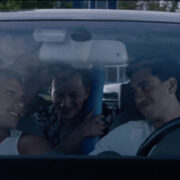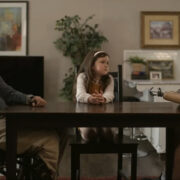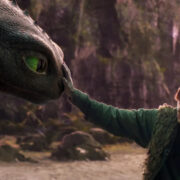LOGAN NOIR: Superior In Black & White
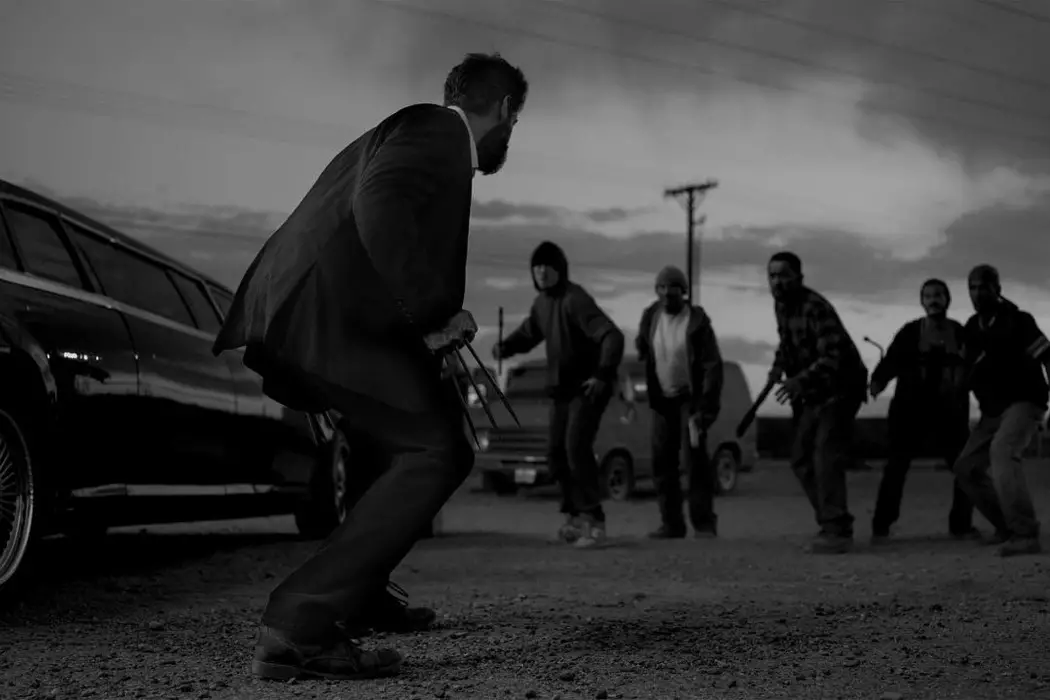
Alex Arabian is a freelance film journalist and filmmaker. His…
What began as a marketing technique evolved into a feature length black and white 20th Century Fox redistribution named Logan Noir. A visceral, violent, sensitive, and heartbreaking film, Logan overwhelmingly exceeded the hype upon release in March 0f 2017. James Mangold’s second entry into the standalone Wolverine franchise marks Hugh Jackman’s last time dawning the now-iconic adamantium claws. Defying genre expectations, the film portrays a vulnerable, aging Logan, pleasing comic book fans, as audiences finally see elements of the Old Man Logan storyline from the Marvel comics.
Much of Logan’s marketing leading up to its release consisted of high definition black and white photos of the Patrick Stewart, Dafne Keene, and Hugh Jackman in character, emanating from old westerns and noir films that inspired Mangold and Jackman’s vision. Filmgoers were pleased so much with the way the black and white contrast emphasized setting and character, that popular demand ultimately led Mangold to theatrically re-release Logan Noir for one night only in the United States through Alamo Drafthouse cinemas, followed by an across-the-country livestream panel discussion with Mangold, Stewart, and producer Hutch Parker (read our transcription here).
Yet again, the black and white version exceeds all expectations, providing a crisper perspective of the fast-paced action scenes, accentuating the aging of Logan and Charles, and creating more focus on the intimate story, character arcs, and minimalist setting. Logan Noir is a labor of love, and what a sight it is to behold.
The Tragedy Of The Commons – Colorless Badlands
Logan was primarily filmed in New Mexico, with two major set pieces constructed at the NASA Michoud Assembly Facility in New Orleans (the oilfield and the Oklahoma City casino hotel). The film’s tone is set immediately with a barren, post-apocalyptic wasteland in the year 2029 that is underscored significantly by the Noir version. The desert looks completely white and, just as it is void of color, it is void of life, with sporadic darkly contrasted plants scattered sparingly across the landscape.
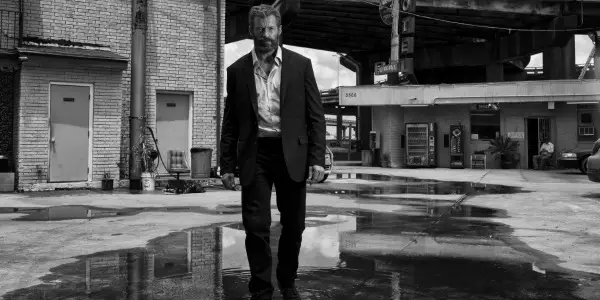
Each billow of dust and gust of dirt emboldened by Logan Noir amplifies the suffocating environment. In the midst of this white hell that emerges through this stark contrast, one can more readily notice old signage along the dirt roads of an era passed, a subtle early nod to a theme that emerges more fully as the film unfolds.
Garrett James Hardin, an American environmentalist and philosopher, came up with the theory of the Tragedy of the Commons, wherein individuals consume what they please without a care for the common good until the world is depleted of most of its natural resources. In Logan, this idea has become a reality. And Mangold makes it a point to show that this is where our world is headed. The fact that a film of this genre is aware of that, is refreshing.
There is no mass destruction and genocide seen in PG-13 superhero films, as that has already happened by overpopulation and the excesses of a distorted capitalist society that Hardin’s theory argues. With no world left to fight for, it opens up other figurative worlds of opportunity to dive deeper into these characters than any film in the franchise has done before.
The characters inhabited in the world of Logan are all affected by it. Minorities and immigrants are used as mules, experimented on by an authoritarian, militaristic government. “Superheroes” have no meaning or place anymore, as mutants are mostly extinct. Their abilities are not seen as a threat, but more as an opportunity to create soldiers. It’s a somber reality whose bleakness is emboldened by Logan Noir’s colorless palate.
Noir’s Lighting Paints Uncompromising Character Portraits
Mangold has essentially stripped the X-Men franchise of its excesses, and taken the powers out of the mutants. The haunting portraits that the Noir treatment paints for the characters allows for the audience to have an easier focus on Mangold’s character development and tender portrait of love and friendship.
James “Logan” Howlett does not live forever, he just ages far slower than the average person. His mutant powers are diminishing, and his ability to heal has slowed. He is psychologically and emotionally damaged from a life of torture, loss, and senseless violence. His alcoholism fuels his diminishing abilities and desire to live, and the adamantium forcefully implanted in him decades earlier is killing him. He takes the brunt of the responsibility for his fallen friends, rejecting the notion of the concept of a hero.
The makeup department ages Jackman at least a decade, an effect that is only improved by the black and white post-production transition process. The contrast brings out the exceptional work of cinematographer, John Mathieson and the lighting department by enhancing each shadow, crease, and wrinkle on his face and the scars that cover his body, allowing the audience to more readily see the pain and internal battle Jackman endures throughout the film. Furthermore, the sweat glistening and dirt accumulated on each character’s face is more noticeable, heightening the effects of Logan’s uncompromising setting.
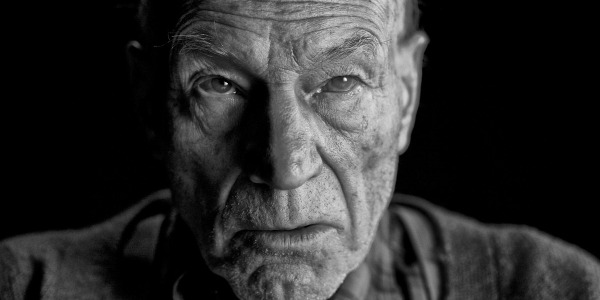
The same effect that Noir has on Jackman’s Logan is amplified further through the appearance of Stewart’s Professor X (Charles). Charles is 90 years old, and his most valuable asset, his mind, is losing cognitive function. His frequent seizures worsen his Alzheimer’s, and, given his telepathy, affect those around him as well. He too is haunted by his past, namely a catastrophic event that one of his seizures caused. Logan’s relationship with Charles has evolved into a deeper father-son kinship, whose moments of reflection happen in Charles’s hideout bunker on the oilfield.
The scenes inside this bunker are breathtaking in black and white. The structure, meant to protect Charles from others, is riddled with bullet-holes, allowing for rays of sunshine to shine through. In Logan Noir, each ray of light offers an evocative reminder of the two last remaining X-Men’s long history together. The glossy black car, which Mangold cites as a central character in and of itself in Logan, stands out amidst the endless desert in Logan Noir, and interior car scenes also make for interesting and revelatory character interactions.
Logan contains small and intimate moments, reveling in its dialogue and characters’ emotional bonding. This is something that has been sorely missed in prior superhero movies. It is a part road-trip, part western, part buddy movie, and part post-apocalyptic tale, with sharp environmental and urgent social commentary. Mangold has created a film that is purely human in every sense of the word. Gone are the lavish CGI-laden special effects of the previous X-Men film installments. Logan is, by all means, a standalone film in the series, but its Noir version feels like an even more unique, arthouse sub-genre.
An Even Bloodier Film In Black And White
The action in Logan is beautifully shot, but not overwhelming, and the violence and carnage is cathartic. Seeing the older titular character fight one last time with his feisty young counterpart provides for some of the most rewarding action sequences seen onscreen in recent memory. Audiences finally see the blood on both of the central characters’ claws, which adds to the realism. In previous installments, there was no blood, as Wolverine used to tear through villains, coming out seemingly spotless. In Logan, and even further in Logan Noir, the viewer can see the full scale of Wolverine’s bestiality
Throughout Logan Noir, the blood is jet black, standing out as the darkest shade of black in the film. Every single drop, for better or for worse, depending on where fans stand on the film’s depiction of violence, is magnified to an even more grisly effect, showing the viewer just how far the blood spreads with each slice of flesh. Especially during the fight scenes at night, of which there are a sizable amount, the viewer can see every movement. It also leaves little to the imagination. The moonlight in the Noir version is amplified, serving as a spotlight to showcase the stabbings, slashing, and beheadings.
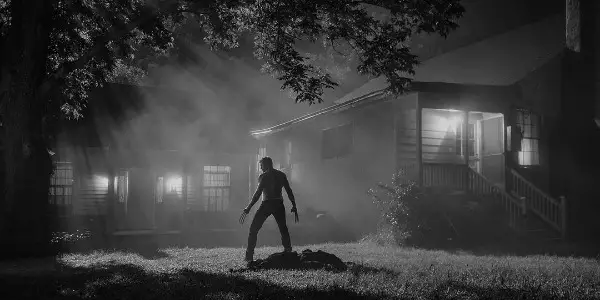
The much-anticipated introduction of Laura Kinney, or X-23, into not only Fox’s X-Men Universe, but the film industry itself, does not disappoint. Dafne Keen as the Wolverine clone is a revelation, utilizing her unique background in gymnastics and aerial arts to astonishing effects. This film will undoubtedly catapult her into stardom. She deftly balances savage aggression (her way of expressing sadness) and raw emotion with a deep longing for familial connection.
However, her athleticism and quickness displayed in the fight scenes, though they are impeccably choreographed and edited, were difficult to follow the first three times viewing Logan in color. Finally, the choice of hues of Mangold’s black and white make Keen’s fight scenes more visible with the help of the black blood in Logan Noir.
Yes, there is cursing. Yes, there is brutal violence, as there should be, given the nature of Logan and Laura’s abilities. There is also a gigantic, bloody heart in Logan’s existential story. The R rating works on so many levels and allows for a more mature story that is not meant to cater to everyone. Its rating eliminates the limitations that a PG-13 rating establishes from making a film like this work.
Mangold said this of the creative freedom the R rating allowed him: “I didn’t want to make a more violent, sexier, more explicit, more obscene movie, I wanted to make an adult movie. This is not a movie for 9-year-old children. When your movie is rated R, you suddenly are making a movie about more grown-up themes. You’re not under the pressure to make a movie for everybody.” Most importantly, the R rating allows Mangold to further confront the inevitability of mortality as well as the fragility of family.
I Take You, Logan Noir, To Be My Lawfully Wedded Wolverine Film
Jackman gives his best performance as Wolverine yet in Logan, pouring his heart and soul into the evolution of a character that he spent 17 years developing. Gone are the quick-witted, cheesy dialogue that the character of Wolverine possessed in Bryan Singer’s previous installments. It is replaced by anger, bitter cursing, and an egoless self-depreciation. Jackman, Keene, and Stewart deserve Oscar nominations for their brave, gritty performances.
The darkening hue of the characters make them a larger emphasis of Logan Noir, allowing the viewer to notice more subtleties added by the actors. Logan is a soulful film as it is, with a foreboding and eerie piano score that seems even more fitting in the black and white universe of Logan Noir. This colorless version is a whole different world, minimizing its already limited setting and unleashing the full scope of the original Logan’s visceral violence.
Johnny Cash’s The Man Comes Around plays as the credits roll, perfectly summing up Logan’s character arc throughout his record-setting 10 turns as Wolverine. At long last, we see the multidimensional character that Logan always was in the comics portrayed onscreen. Viewers who are sentimental should not forget to bring tissues to the theater.
Do not miss the shocking and euphoric climax of Logan. As Jackman said, this is his love letter to the loyal fans of his indelible portrayal of the adamantium-plated mutant. It most certainly shows. And, in a sense, Logan Noir is Mangold’s own love letter to the fans of his Wolverine installments. Though it is not customary to end on a quote, Mangold perfectly summed up Logan Noir’s essence following the screening:
“I started releasing some of the photos [on social media platforms during filming] and they were in black and white, and the fans’ response was huge. And I thought our lighting and Hugh and all the characters looked fabulous in black and white. And it just struck us that we should see this on the big screen…and even just one night, seeing this movie this way, helps people see that there are audiences out there for monochrome movies, for a different kind of movie.”
Did you like Logan? Are you excited to see Logan Noir? Is black and white merited, or is it too pretentious?
Logan Noir was released theatrically for one night only in the US on May 16. Logan fans can purchase the Blu-Ray release of Logan on May 23 to see the Logan Noir version in the bonus content.
Watch Logan
Does content like this matter to you?
Become a Member and support film journalism. Unlock access to all of Film Inquiry`s great articles. Join a community of like-minded readers who are passionate about cinema - get access to our private members Network, give back to independent filmmakers, and more.
Alex Arabian is a freelance film journalist and filmmaker. His work has been featured in the San Francisco Examiner, The Playlist, Awards Circuit, and Pop Matters. His favorite film is Edward Scissorhands. Check out more of his work on makingacinephile.com!



